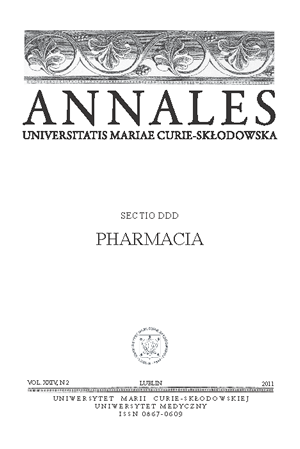Influence of the concentration of oil phase on rheological properties of nonisotonic parenteral emulsions
Keywords:
fluidity, parenteral emulsions, rheology, thixotropyAbstract
Five emulsions were made of soybean oil, human albumin and lecithin-in fixed amounts and water - in decreasing amounts. They were prepared aseptically. After homogenization the rheological measurements were carried out using a rotational viscometer "Rheotest 2". Knowing the shear stress values (Tr) at the corresponding values of shear rates (Dr), the dynamic viscosity was calculated (η), and then the fluidity (ф ) of analyzed preparations which are presented in figures as a function of ф = f(DrN).
Studies indicate that these systems are characterized by pseudoplastic flow andthey show thixotropy, which increases with decreasing water phase. Their fluidity can be described by the general equation ф = K(DrN), where: K - speed fluidization, Dr - shear stress, N - power exponent.
References
1. Alonso Perez L.et al: Intravenous lipid emulsions in pediatric parenteral nutrition. Acta Pediatrica Espanola, 67, 387, 2009.
2. Benita S., Levy M.Y.: Submicron emulsions as colloidal drug carriers for intravenous administration, J. Pharm.Sci., 82, 11, 1993.
3. Czarnecki W., Wiktorowicz M.: Porównanie właściwości reologicznych podłoży polietylenowych, Farm.Pol., 49, 1, 1993.
4. Driscoll D.F.: Lipid injectable emulsions, Parenteral and Enteral Nutrition,21,381,2006.
5. Jimenez M.M. et al.:Stability and rheology of dermopharmaceutical excipient formulated with honey, STP Pharma Sci., 5, 216, 1995.
6. Jumaa M., Muller B.W.: Development of a novel parenteral formulation for tetrazepam using a lipid emulsion, Drug Develop. and Indust. Pharm., 27,1115,2001.
7. .Jumaa M., Muller B.W.: Formulation and stability of benzodiazepines in a new lipid emulsion formulation, Pharmazie, 57, 740, 2002.
8. Kari A., Hersio K., Takala J., Pentilla J.: Comparison of two long-chain triglyceride fat emulsion in parenteral nutrition of critically ill patients, Current Therap. Research, 45, 6, 1989.
9. Koycha M.et al.: Stabilite des melanges ternaires pour nutrition parenterale, STP Pharma Sci., 4,169, 1994.
10. Medina J. et al. : Use of ultrasound to prepare lipid emulsions of lorazepam for intravenous injection, Int. J. Pharm., 216, 1, 2001.
11. Muchtar S. et al.: Stability assessment of a fat emulsion prepared with an original mixture of purified phospholipids, STP Pharma Sci., 1,130, 1991.
12. Sila-on W.et al.: Influence of incorporation methods on partitioning bahaviour of lipophilic drugs into various phases of a parenteral lipid emulsion. AAPS Pharm. Sci. Tech., 9, 684, 2008.
13. Silvander M. et al.: Rheological properties of phospholipid-stabilized parenteral oil-in-water emulsions, Int. J. Pharm., 252, 123, 2003.
Downloads
Published
Issue
Section
License
Copyright (c) 2011 Authors

This work is licensed under a Creative Commons Attribution-NonCommercial-NoDerivatives 3.0 Unported License.


